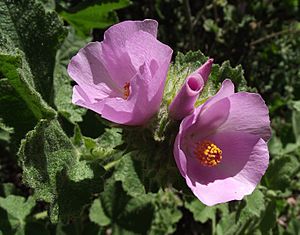Santa Lucia bushmallow facts for kids
Quick facts for kids Santa Lucia bushmallow |
|
|---|---|
 |
|
| Scientific classification | |
| Genus: |
Malacothamnus
|
| Species: |
lucianus
|
The Malacothamnus lucianus is a type of flowering plant. It belongs to the mallow family. People often call it the Arroyo Seco bushmallow or Santa Lucia bushmallow. Sometimes it's also known as the Hanging Valley bushmallow. This plant grows only in one special place: Monterey County, California. You can find it in the Santa Lucia Mountains there. When a plant or animal lives only in one specific area, we say it is endemic to that place.
Contents
About the Arroyo Seco Bushmallow
How It Was Named and Classified
Scientists first described the Arroyo Seco bushmallow in 1955. Back then, they thought it was just a type of another plant called Malacothamnus palmeri. For many years, it was considered a variety of that plant. But in 2021, after more study, scientists decided it was unique enough to be its own separate species. This means it got its own special name, Malacothamnus lucianus.
What Makes It Special
The Arroyo Seco bushmallow has some unique features that help scientists tell it apart from other plants.
- It has flower clusters that are shaped like a head or a rounded clump.
- It also has special hairs called "glandular trichomes" that are quite long. These hairs can be 0.3 to 1.4 millimeters long.
- Another interesting thing is that the plant often has a slightly strong or "rancid" smell. This smell is not usually found in its close relatives.
How It's Different from Similar Plants
It can be tricky to tell the Arroyo Seco bushmallow apart from its cousins, Malacothamnus palmeri and Malacothamnus involucratus. But there are a few key differences:
- The stem of the Arroyo Seco bushmallow has star-shaped hairs. Many of the "rays" (or arms) of these hairs are 1 to 3 millimeters long.
- In contrast, the other two plants usually have star-shaped hairs with shorter rays, less than 1 millimeter long.
- Also, the glandular hairs on Malacothamnus palmeri and Malacothamnus involucratus are much shorter, usually 0.1 millimeters or less.

